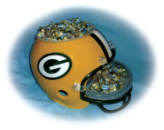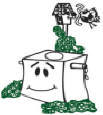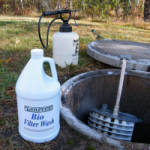



Bio - Products, Packaging & Marketing Experts



All Rights Reserved - Lenzyme - 2010 - 2020
Diagnosing Septic Tank Problems
"Diagnosing septic tank problems" is very difficult. There are many variables to be reviewed when trying to diagnose a septic system problem. Do you have a septic tank problem? Or do you have a drainfield problem? Or do you have a problem with a backed up septic system because of mechanical malfunctions. Septic backups could be as simple as clogs in your drain lines running to your septic system, or a clogged septic tank filter. Professional septic advice is recommended when you are septic tank troubleshooting or diagnosing a septic system failure. If you don't know what you are doing a failed septic tank can be a dangerous place. There are plenty of stories about people being overcome by methane gases when dealing with a problem septic tank. Your septic professional has the experience to diagnose a problem septic, and should be the first person you call when you have a failed septic tank or a failed septic system drainfield. Start by calling the septic company you use to have your regularly scheduled septic cleanout and septic field inspections. Before you begin diagnosing septic tank problems you should understand the septic system design and types of septic systems you have. Once you know the septic tank design and septic tank location of your septic system parts, you are ready to start diagnosing septic tank problems based on your system and the various septic parts. Make sure to always keep a copy of your septic system layout in your important papers file. If you don't have one call your septic tank installer, builder, or county where your septic tank permit is filed for a copy of the septic tank diagram. Find out more about how a septic tank works and about septic tank care by watching this video.
Septic system problems will result in messy cleanups, inconvenient smells and septic system odor in your house, plus possible septic tank replacement. Of course your septic system backup will always happen when you are about to have guests arrive!
2.) Broken drain lines or broken septic tank baffles
3.) Tree roots getting into cracks in the tank or around septic tank cover
4.) Septic Filter clogging from not having it properly cleaned on a regular basis
5.) Inadequate septic tank bacteria & septic enzyme populations
7.) Grease capping from too much grease entering the septic system
8.) Bio-mat and or sulfite build up (Drainfield bio-mat balancing problem)
9.) Broken drainfield piping or compacted soil
10.) Clogged drainfields from tree roots
11.) Old septic tank designs and improper location of the drainfield


OK, now on to some possible solutions to your septic system problems. These are general guidelines and solutions which are based on our 35+ years of solving clogged septic systems through our professional septic contractor network. All septic tank problems can be fixed with proven septic system restoration techniques. Some will require very little time and cost, others can amount to a substantial investment of time and money. Again it is best to use a professional who is familiar with septic tank dimensions and septic tank sizes, or at least has some knowledge and experience in diagnosing septic system problems. Better yet, you should be doing everything possible to protect and maintain your septic system. Once your septic system contractor is done diagnosing your septic tank systems problem, follow these solutions to get your failed or backed up septic tank and septic drain fields working properly again.
Septic tank problem: Sludge build up from not following proper septic tank pumping procedures.
Septic tank problem:
Broken drain lines or broken septic tank baffle.
Solution:
This septic failure problem is best fixed by a professional with the right equipment. Look for a contractor with camera equipment who can do a complete septic tank inspection to locate the broken drain lines, or other broken septic tank parts. Contractors with backhoe equipment for digging can also use a septic dye to find broken lines. Broken septic tank baffles result from sulfuric acid eating away at concrete baffles or rust eating away at steel baffles. Most septic professionals can handle the replacement of deteriorated baffles. Keep in mind that an early sign of concrete or steel septic tanks failure is baffles having to be replaced. You might want to consider having the whole septic tank ( just the tank, not the drainfield ) replaced with a modern fiberglass septic tank and septic tank filter system.
Septic tank problem: Tree roots getting into cracks in the tank or around septic tank covers and septic tank risers.
Septic tank problem:
Septic filter clogging from not having it properly cleaned on a regular basis.
Solution:
This is a pretty common problem and can easily be corrected with very little effort and cost. One of the best septic products developed was septic tank outlet filters, because they help protect the drainfield from getting overloaded with too many solids. New poly septic tanks, plastic septic tanks, and other modern septic tanks all come with septic tank filters. Most places now have septic tank regulations requiring septic tank filters. Most septic contractors clean and inspect your septic filters while cleaning septic tanks. Some septic filters can be cleaned by the septic owner themselves if you care to do that type of work.
Many contractors use a high quality biological cleaning agent which helps with the washing of the complete septic filter. Do not uses harsh chemical cleaners if you are cleaning the septic filter because it could kill valuable bacteria within the septic tank and drain field.
Simply follow the manufacturers instructions on pulling the filter and then wash it down with your garden hose. Examine the filter while cleaning for signs of potential corrective actions. The filter could be clogged by paper, grease, or untreated solids. These are all signs of problems within the septic tank and you need to take action to restore proper septic tank operation.

Solution: This is the number one reason for most septic tank backups. Please review the proper ways to maintain your septic system so solids don’t buildup unnecessarily in your septic tank and reduce your septic tank capacity. Follow proper septic maintenance by watching what you put in, have high levels of biological activity present, and have it cleaned on a regular schedule. To solve this buildup, have a professional come out and clean your tank. Have them apply our septic tank treatment products to help keep your septic free from sludge overloading. If you are currently using a retail grade product, or were sold a product over the phone, you likely have a very low quality septic additive. Watch the Cat Food Test video to see the difference in quality of septic system additives. You should also ask them to treat your septic drainfield because solids did escape your tank and now are going to build up in your drainfield. If you do not treat the drainfield you will have a drainfield problem in the near future, because of bio-mat and sulfate clogging.
Solution: Tree roots can really do a lot of damage to septic systems and make them work slowly or stop working completely. Of course whole trees can be removed and the roots killed by many different types of contractors. Don’t think you are going to pick up a small container of copper sulfate or other root killer at your local store and believe it will solve your root problems. If a root is cut it will grow back in a very short period of time, and it will come back with more vigor. You need a professional who knows the best way to attack your root problem. Treating roots in the septic tank is different then treating roots in the septic drainfield. Also these professionals will know the environmental laws affecting the use of certain root killing chemicals. Our professional contractors use an environmentally safe treatment, sometimes combined with root cutting to attack and treat root problems. This is not an area for the DIY septic system person, use a contractor with the knowledge, experience, and the right equipment for the job.
We hope this information has helped your septic system troubleshooting. Septic problems are a hassle and we know it can be frustrating, but the more you know about your overall septic system the easier it is to make an informed decision when you have a septic tank problem or a drainfield problem. Of course these types of problems can be avoided by following proper maintenance for septic tank systems. Know what should and should not go into your septic system and maintain high levels of biological activity in both the septic tank and septic drainfield. Also remember to have regularly scheduled cleanings of the septic tank, filters, and septic system drainfield.
See Lenzyme Bio Filter Wash in Action

